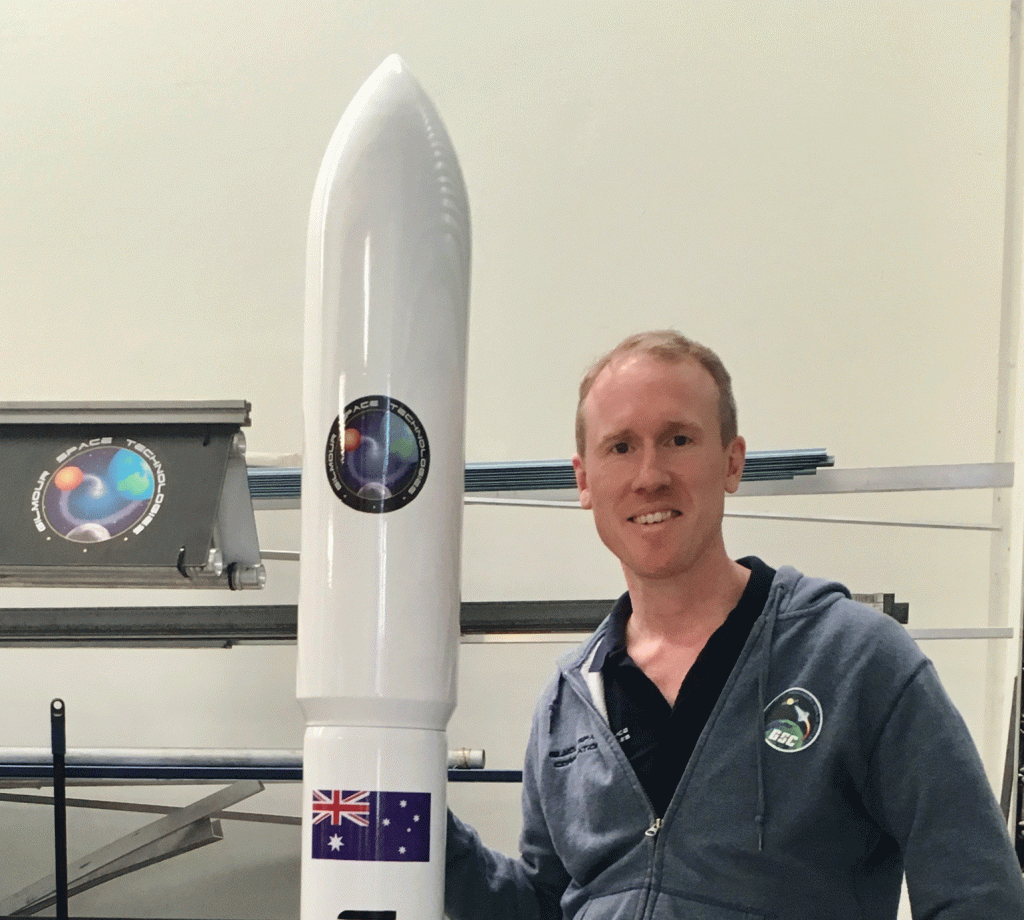Gold Coast-based Gilmour Space Technologies has test-fired their orbital class G-70 hybrid-fuelled rocket engine, thought to be the largest of its kind. CEO and founder Adam Gilmour says the company is now closer to their goal of sending small, low-cost satellites into space.
The company plans to use just one G-70 engine to launch their first payload into suborbital space in June this year, as long as they receive regulatory approval.
The payload will include cargoes from three universities in Australia and Singapore, including a GPS tracking system developed at UNSW.
While most rocket engines use either solid or liquid fuel, hybrid engines combine a solid fuel with liquid oxidiser. When the liquid oxidiser passes through the solid fuel in a chamber, they combust to form high temperature gases, which pass through a nozzle to provide thrust.
“We chose hybrid rockets because they’re simpler, cheaper, environmentally greener and a lot less explosive than solid or liquid rockets,” Gilmour said.
Given these advantages, it might seem surprising that hybrid engines are not more widely used. Gilmour explained that hybrid engines have been “notoriously difficult” to scale up, limiting their efficiency and performance.
Not too fast, not too slow, just right
According to Gilmour, part of the problem in scaling up hybrid engines is that traditional hybrid fuels burned either too fast or too slowly. Slow-burning fuels did not provide enough surface area to provide a large thrust, and fast-burning fuels tended to have structural issues such as slumping or melting in larger engines.

Gilmour Space first tested their fuel in 2016, when they launched a subscale rocket 5 km into the air, and completed a 45 kN low pressure test fire of the 46 cm diameter G-70 engine in January.
The full pressure test fire of the G-70 earlier this month achieved bigger things – delivering a peak thrust of 70 kN.
“Gilmour Space has demonstrated capability in what could be the largest successful test fire of a single-port hybrid rocket engine,” Gilmour said.
Hybrid engines have liquid oxidiser injected into the solid fuel through either a single or multiple ports. Larger hybrid engines often use multiple ports, although Gilmour said that the single port configuration is believed to be more fuel efficient.
In “new space”, things are getting a lot cheaper, according Gilmour.
“Projects that used to cost tens or hundreds of millions of dollars can now get started with less than $100,000,” he said.
Gilmour Space will offer low-cost launches to small satellite developers, giving them the chance to take their place in the global market.
One company which Gilmour is looking to collaborate with is South Australian Fleet Space Technologies, who are gearing up to launch a constellation of nanosatellites to provide free connectivity for the Internet of Things.
“Fleet is developing a constellation of small satellites that will operate in low earth orbit, and Gilmour Space is developing a low-cost launch vehicle specifically for that purpose. Our goal is to be best-in-class for small payload launches in terms of reliable, inexpensive and responsive access to space,” Gilmour said.
By 2020, Gilmour anticipates launching small satellites of up to 400 kg into low earth orbit (LEO). These satellites could be used for applications including earth observation, space-based broadband and remote sensing.
Australia can be an international player
Gilmour said that Australia should “think big” and not assume that other countries are better at developing ideas and technologies.
And Gilmour Space is certainly thinking big. As well as preparing for their LEO launches from 2020, they are the first Australian startup to sign a Space Act Agreement with NASA.
According to Dr Alice Gorman, space archaeologist and senior lecturer at Flinders University, Gilmour is breaking ground to make Australia competitive in the global space market.
“It’s been assumed for decades that Australia can’t compete in the launch market, but Gilmour Space is showing that this isn’t true,” she said.
